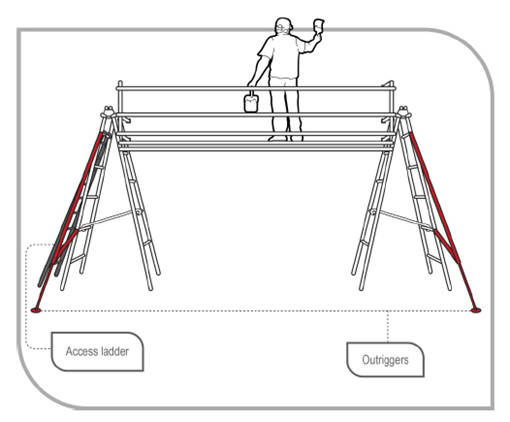Trestle ladder scaffolds fact sheet
Learn what trestle ladder scaffolds are, when edge protection is required, and how to access them safely.
A trestle ladder scaffold is a scaffold which has decking components supported at either end by trestle ladders.
Trestle ladder scaffolds are light duty (max. 225kg) only. They are often used by painters, signwriters, electricians and similar for light duty work such as using hand tools.
Trestle scaffolds are a different type of scaffold used for light, medium, heavy, or special duty work. Learn more about trestle scaffolds.
The hazards
Hazards when using trestle ladders scaffolds include:
- Falls
- Overturning or collapse
- Structural failure due to overloading
Must do’s
Trestle ladder scaffolds should be:
- erected in accordance with the manufacturer’s instructions, e.g.: ladders fully open, outriggers extended, edge protection fitted
- erected on a firm, even, stable supporting surface
- erected so working platforms are level and not more than 5m above the supporting surface
- fully planked (minimum 450mm wide), with gaps between decking components not exceeding 20mm, and any plank overhang in accordance with the manufacturer’s requirements
- single lift only
- limited to a single bay, unless a run of multiple bays is permitted by the manufacturer
- erected by a person holding a minimum basic scaffolding (SB) high risk work licence if a person or object could fall more than 4m from the platform to any other level
- provided with a handover certificate if a person or object could fall more than 4m from the platform.
- Provided with suitable access
- Provided with edge protection where required
Trestle ladder scaffolding systems should comply with:
- AS 1576.5 Scaffolding, Part 5: Prefabricated trestle and trestle ladder scaffolds
- AS 1892.1 Portable Ladders – Performance and geometric requirements
- AS 1577 Scaffold decking components
When edge protection is required
If a trestle ladder scaffolding system is designed to incorporate edge protection it should only be omitted:
- if such use is allowed by the manufacturer, and
- a risk assessment has determined a fall from the platform is not reasonably likely to cause injury.
Edge protection is required on trestle ladders scaffolds where the platform height exceeds 2m above the supporting surface. Edge protection is also required for platforms below 2m if the scaffold is erected next to a hazard that means:
- a fall of more than 2m is possible, or
- a fall from the platform would be reasonably likely to cause injury.
Examples include erecting the scaffold adjacent to:
- Voids, balconies or penetrations
- Weak, friable or non-trafficable surfaces
- Impalement hazards such as exposed reo, pipes, bars and similar
- Electrical, chemical or biological hazards
Edge protection should be installed in accordance with the manufacturer’s instructions.
Not all trestle ladder scaffolds are strong enough / stable enough to have edge protection installed. Such scaffolds cannot be used if edge protection is required.
Accessing trestle ladder scaffolds safely
Trestle ladders scaffolds should be accessed by climbing the ladder cross bearers or by independent means, e.g.
- Secured ladder that extends past the working platform
- Direct access from an adjacent structure or platform
When climbing the ladder cross-bearers, typically only one end is used for access, with the other end incorporating edge protection.
Related information
- SafeWork NSW Code of Practice: Managing the risk of falls at workplaces
- SafeWork NSW Code of Practice: Managing the risk of falls in housing construction
- Safe Work Australia Guide: Scaffolds and Scaffolding
- SafeWork NSW scaffolding
- SafeWork NSW working at heights
- AS 4576 Guidelines for scaffolding
- AS/NZS 1576.1 Scaffolding, Part 1: General
